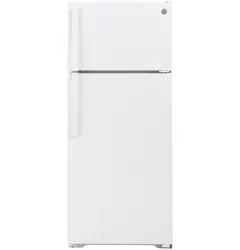Documents: Go to download!
User Manual
- User Manual - (English, French, Spanish)
- Quick Specs - (English)
- Spec Sheet (web) - (English)
- USING THE REFRIGERATOR
- Care And Cleaning
- TROUBLESHOOTING TIPS
Table of contents
User manual Refrigerator
USING THE REFRIGERATOR
Temperature Control
The temperature control adjusts the refrigerator from its warmest to coldest settings.
Your refrigerator will come with the recommended factory setting on "3". For colder temperature, turn the knob clockwise to either setting "4" or "5". For warmer temperature, turn the dial counter-clockwise to either setting "1" or "2". To turn off the cooling in both compartments, turn the knob counter-clockwise to setting "Off". Note that this does not shut off power to the refrigerator.

Garage Operation
Models with dual temperature control have an adjustable freezer control and can be operated in locations with ambient temperatures between 38-110°F (3.3-43.3°C). For cold ambient conditions 38-54°F (3.3-12.2°C) the fresh food should be set to setting 2 to prevent food from freezing in the fresh food compartment, and the freezer setting should be adjusted to position 5 to prevent food from thawing in the freezer compartment.

Sabbath Mode
This product is capable of entering a Sabbath Mode. Sabbath mode requires that the control knob and light switch are operated at the same time. The light switch is located just to the left of the control knob. To enter
Sabbath Mode, turn the control knob to position 5, then hold down the light switch. While the light switch is held down, turn the control knob to position 3. Once the control knob is in position 3, release the light switch. When you release the light switch, the light will turn off and the product is in Sabbath mode. To exit
Sabbath mode, enter the same control knob/ light switch sequence used to enter Sabbath mode. If Sabbath mode is not exited manually, it will end automatically after 96 hours. If power is disconnected from the product while it is in Sabbath mode, it will remain in Sabbath mode after power is reconnected. Sabbath mode does not deactivate the icemaker, if present. The icemaker must be turned off manually by moving the icemaker switch to the off position. The icemaker switch is located on the icemaker in the freezer compartment.
Fresh Food Compartment Shelves
Shelf supports at various levels allow you to custom-space your shelves. Not all features are on all models.
Full-Width Shelves
Some models have a stationary tempered glass shelf or two steel wire stationary shelves. These shelves can be moved to another place in the fresh food compartment.
When placed correctly on the shelf supports, the shelf will stop before coming completely out of the refrigerator and will not tilt when you place food on it or remove food from it.
Pull glass shelves forward so the glass rests evenly on side rails. For units with glass shelves, rail positions 2 and 4/5 are recommended.
CAUTION
Do not clean glass shelves or covers with warm water when they are cold. Glass shelves and covers may break if exposed to sudden temperature changes or impact such as bumping or dropping. Tempered glass is designed to shatter into many small pieces if it breaks.
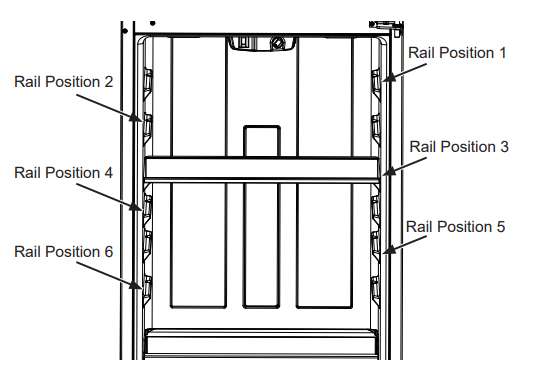

Freezer Compartment Shelves
When placed correctly on the shelf supports, the steel wire stationary shelves will stop before coming completely out of the freezer and will not tilt when you place food on it or remove food from it.
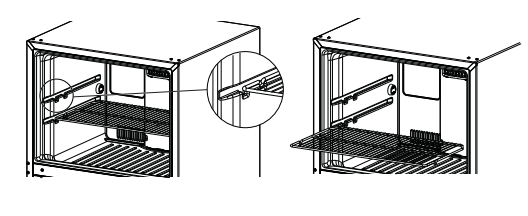
Some models have glass shelves.
CAUTION
Do not clean glass shelves or covers with warm water when they are cold. Glass shelves and covers may break if exposed to sudden temperature changes or impact such as bumping or dropping. Tempered glass is designed to shatter into many small pieces if it breaks.
Storage Drawers
Not all features are on all models.
Snack Drawer
The snack drawer can be moved to the most useful location for your family's needs.
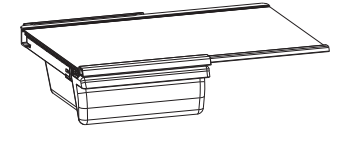
Fruit and Vegetable Drawers
Excess water that may accumulate in the bottom of the drawers should be emptied and the drawers wiped dry.

Drawer and Cover
Drawer Removal
Drawers can be removed easily by grasping the sides and lifting up slightly while pulling drawers past the stop location.
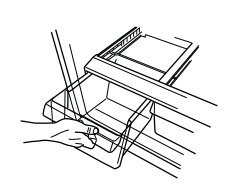
Cover Removal
- Remove the drawers.
- Reach in, push the back of glass cover up, and at the same time, pull it backward as far as it will come. Tilt it and take it out. Avoid cleaning the cold glass cover with hot water because the extreme temperature difference may cause it to break.

- Remove the drawer frame. (Always remove the glass cover before you take out the drawer frame.) Lift the frame off the supports at each side and back, pull it forward, tilt it and take it out.
To replace:
- Lower the frame until it rests on the supports at each side and back.
- Replace the glass cover, pushing its front edge firmly into the front frame channel and gently. lowering the back into place.
- Replace the drawers.
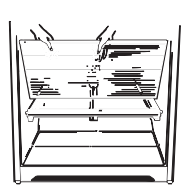
Automatic Icemaker (on some models)
Not all features are on all models.
WARNING Connect to potable water supply only.
A cold water supply is required for automatic icemaker operation. The water pressure must be between 40 and 120 psi (275-827 kilopascals).
CAUTION
Avoid contact with the moving parts of the ejector mechanism, or with the heating element (located on the bottom of the ice maker) that releases the cubes. Do not place fingers or hands on the automatic ice making mechanism while the refrigerator is available at extra cost. plugged in.
A newly-installed refrigerator may take 12-24 hours to begin making ice.
The ice maker will produce approximately 70-100 cubes in a 24-hour period, depending on the freezer compartment temperature, room temperature, number of door openings and other use conditions.
If the refrigerator is operated before the water connection is made to the ice maker, set the switch OFF.
When the refrigerator has been connected to the water supply, set the switch ON position.
The ice maker will fill with water when it cools to 15°F (-9°C). A newly-installed refrigerator may take 12 to 24 hours to begin making ice cubes.
Once the ice maker starts to make ice, it may take up to 48 hours to fill the bin, depending on the temperature settings and number of door openings.
You will hear a buzzing sound each time the ice maker fills with water.
NOTICE: Throw away the first few batches of ice to allow the water line to clear.
When the bin fills to the level of the feeler arm, the ice maker will stop producing ice.
It is normal for several cubes to be joined together.
If ice is not used frequently, old ice cubes will become cloudy, taste stale, shrink or fuse together.
Ice maker accessory kit:
Be sure nothing interferes with the sweep of the feeler arm.
If your refrigerator did not already come equipped with an automatic ice maker, an ice maker accessory kit is
This refrigerator will accept accessory icemaker kit IM-4D or IM-6D. Use instructions X supplied in the kit for assembly.
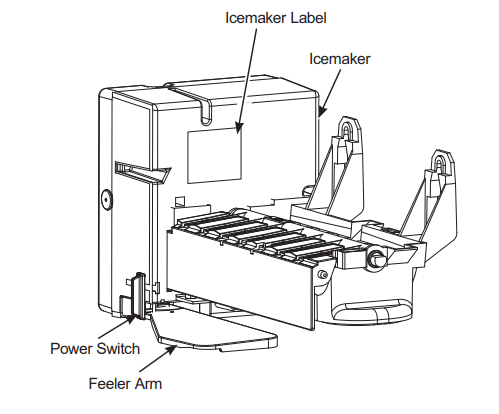
IMPORTANT: This refrigerator requires a red label icemaker. See above for the location of the label on the icemaker. If the icemaker that came with your kit does not have a red label, it will not function. In this case, please call 800.GE.CARES (in Canada 800.561.3344) for the correct icemaker.
Care And Cleaning
Cleaning the Outside

Cleaning the Inside
To help prevent odors, leave an open box of baking soda in the fresh food and freezer compartments.
Unplug the refrigerator before cleaning. If this is not practical, wring excess moisture out of sponge or cloth when cleaning around switches, lights or controls.
Use warm water and baking soda solution-about a tablespoon (15 ml) of baking soda to a quart (1 liter) of water. This both cleans and neutralizes odors. Rinse and wipe dry.
After cleaning the door gaskets, apply a thin layer of petroleum jelly to the door gaskets at the hinge side.
This helps keep the gaskets from sticking and bending out of shape.
CAUTION
Do not clean glass shelves or covers with warm water when they are cold. Glass shelves and covers may break if exposed to sudden temperature changes or impact such as bumping or dropping.
Tempered glass is designed to shatter into many small pieces if it breaks. Do not wash any plastic refrigerator parts in the dishwasher.
Moving the Refrigerator
Be careful when moving the refrigerator away from the wall. All types of floor coverings can be damaged, particularly cushioned coverings and those with embossed surfaces.
Turn the leveling legs at each front corner of the refrigerator counterclockwise until the rollers support the refrigerator. Pull the refrigerator straight out and return it to position by pushing it straight in. Moving the refrigerator in a side direction may result in damage to the floor covering or refrigerator.
When pushing the refrigerator back, make sure you don't roll over the power cord or ice maker supply line (on some models).
After rolling the refrigerator back into place, turn the legs clockwise until the legs again bear the weight of the refrigerator.
Replacing the Lights
LED lighting is located at the top center of the fresh food compartment.
An authorized technician will need to replace the LED light.
If this assembly needs to be replaced, call GE Appliances Service at 1.800.432.2737 in the United States or 1.800.561.3344 Canada.
Preparing for Vacation
For long vacations or absences, remove food and unplug the refrigerator. Move the temperature control dial to the OFF position, and clean the interior with a baking soda solution of one tablespoon (15 ml) of baking soda to one quart (1 liter) of water. Leave the doors open.
Move the switch to the OFF position on the power switch model, and shut off the water supply to the refrigerator.
If the temperature can drop below freezing, have a qualified servicer drain the water supply system (on some models) to prevent serious property damage due to flooding.
Preparing to Move
Secure all loose items such as grille, shelves and drawers by taping them securely in place to prevent damage. To prevent the doors from opening while moving, secure them to the case with tape. Be sure the refrigerator stays in an upright position during moving.
TROUBLESHOOTING TIPS
Normal Operating Conditions.
Newer refrigerators sound different from older refrigerators
Modern refrigerators have more features and use newer technology
Do you hear what I hear? These conditions are normal.

- The new high efficiency compressor may run faster and longer than your old refrigerator and you may hear a high-pitched hum or pulsating sound while it is operating.
- You may hear a whooshing sound when the doors close. This is due to pressure equalizing within the refrigerator.
CLICKS, POPS, CRACKS and CHIRPS
- You may hear cracking or popping sounds when the refrigerator is first plugged in. This happens as the refrigerator cools to the correct temperature.
- Expansion and contraction of cooling coils during and after defrost can cause a cracking or popping sound.
- The compressor may cause a clicking or chirping sound when attempting to restart (this could take up to 5 minutes)
- On models with an ice maker, after an ice making cycle, you may hear the ice cubes dropping into the ice bucket.

- You may hear the fans spinning at high speeds.This happens when the refrigerator is first plugged in, when the doors are opened frequently or when a large amount of food is added to the refrigerator or freezer compartments. The fans are helping to maintain the correct temperatures.
WATER SOUNDS

- The flow of refrigerant through the cooling coils may make a gurgling noise like boiling water.
- Water dropping on the defrost heater can cause a sizzling, popping or buzzing sound during the defrost cycle.
- A water dripping noise may occur during the defrost cycle as ice melts from the evaporator and flows into the drain pan.
- Closing the door may cause a gurgling sound due to pressure equalization.
The automatic ice maker in my refrigerator will produce ice when the refrigerator is plugged in to a power receptacle. MYTH
- The refrigerator must be connected to water, and the ice maker must be turned on. Make sure the ice maker is turned on, only after the water line is connected and water is turned on. The ice maker can be turned off by switching it to the OFF position.
- The freezer must be 15 degrees or colder before the icemaker will produce ice. Please allow at least 24 hours for the refrigerator to pull down and the unit's temperature to stabilize.
I will never see frost inside the freezer compartment. MYTH
- Frost inside the freezer typically indicates that the door is not properly sealed, or has been left open. If frost is found, clear the frost using a plastic spatula and towel, then check to ensure that no food packages or containers are preventing the freezer door from closing. To help reduce to the potential for frost please make sure there is proper clearance to the air supply and vents in the freezer to improve circulation. Always cover food before loading into the refrigerator, moisture from open containers can add to the frost load.
Refrigerator door handles can be easily tightened.TRUE
- If door handles are loose or have a gap, the handle can be adjusted with set screws located on the ends of the handles.
After starting the ice maker throw away 24 hours of ice production. TRUE
- To avoid issues with odor and taste the first batch of ice should be discarded
Door removal is always required for installation. MYTH
- Doors should only be removed when necessary to prevent damage from passage way or access to final location. If doors are removed please review Reversing the Door Swing section for re-hang procedure.
There is an adjustment to rear wheels.MYTH
- Front leveling legs are adjustable and should be used to balance the refrigerator.
- Leveling legs are used to make initial fresh food door adjustment. There should be approximately a % fall from the front to back to ensure that the doors always close.
Any All-Purpose cleaner can be used to clean my refrigerator. MYTH
- All-purpose cleaners are not recommended for use on the refrigerator.
- Do not use wax, polish, ammonia, bleach, or other products containing chlorine on for any surfaces. Clean with a cloth dampened with soapy water. Dry with a soft cloth.
- The stainless steel doors can be cleaned with a commercially available stainless steel cleaner. Cleaners with oxalic acid such as Bar Keepers Friend Soft Cleanser™ will remove surface rust, tarnish and small blemishes. Use only a liquid cleanser free of grit and rub in the direction of the brush lines with a damp soft sponge. Do not use appliance wax or polish on the stainless steel.
Gaskets will last longer with regular cleaning and maintenance. TRUE
- Clean gaskets with warm soapy water. Make sure all folds are clean and dry after cleaning. Make sure flanges are clear of any grit or grime. After cleaning the door gaskets, apply paraffin wax or petroleum jelly to the door gaskets and hinges at the hinge side. This helps keep the gaskets from sticking and bending out of shape.
Doors may be shipped with protective film that has to be removed before use.TRUE
- Smooth finished doors (Stainless, Slate, Gloss Black and Gloss White, or Silver Metallic) will have a clear plastic film on the door that must be removed after install.
See other models: GZS22DMJES JGBS61DPWW GZS22DSJSS JN327HWW JGBS61DPBB
